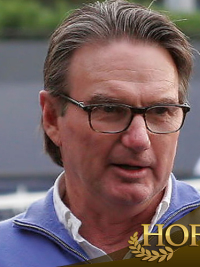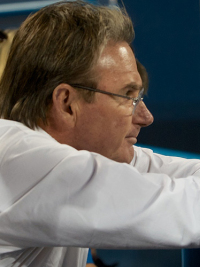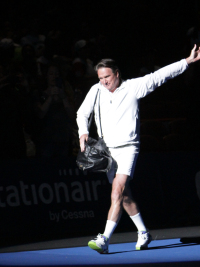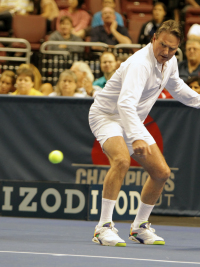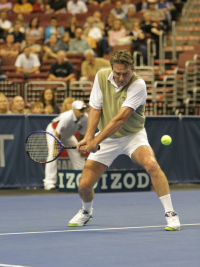Jimmy Connors
Full name: James Scott Connors
Nickname: Jimmy, Jimbo, the George Best of tennis
Nickname: Jimmy, Jimbo, the George Best of tennis
| Born |
Subscribe now
This information and data is not available because you are not our subscriber yet.
Please click here and get full access to the entire database! |
|---|---|
| Class of HOF | |
| Height | |
| Weight | |
| Plays | |
| Coach | |
| Bio | A marvel of longevity and self-motivation, he is (as one-time agent Bill Riordan boasted) "the one and only James Scott Connors." Fiery of temperament and shot making, this lefty with a two-fisted backhand pounded foes for more than two professional decades in rip-roaring baseline style, a rag-doll throwing himself into his groundies with utter gusto. Often controversial, he fought verbally with opponents, officials and the crowd. Considered a feisty wise guy in his earlier days, he eventually became a respected elder. The championships, honors and prize money piled up, but not as high as his zeal as he continued to compete forcefully against much younger men into his 41st year and through the 1992 season when he roused galleries in Paris, London and New York and compiled a 17-15 match record, ending the season with a remarkable No. 83 ranking. Turning pro in 1972, Jimmy won his first title that year at Jacksonville, Fla., and continued at a prodigious pace, arriving at his 109th - a male record - in 1989 by winning Israel. He attained 54 other finals, and played more tournaments (401) and won more matches (1,337-285, a .824 mark), than any other male pro, and, in fact, never announced his retirement. He also won 19 doubles titles, two of them majors: Wimbledon, 1973, and the U.S., 1975, both with Ilie Nastase. Having lost a first-rounder at Atlanta in 1996, he was the only player who had been on the ATP computer since its inception in 1973, latest ranking a not-too-shabby No. 1,304 at age 44, having been World No. 1 five straight years, 1974-78, an open era record until surpassed by Sampras' six, 1993-98. His specialty has been the U.S. Open (five championships), where he was singular in winning on all three surfaces: Grass (1974) and clay (1976) at Forest Hills, and hard (1978, 1982, 1983) at Flushing Meadow. He also won Wimbledon twice (1974 and 1982) and the Australian (1974) for a total of 8 singles majors, tied with Andre Agassi and behind only to Sampras (14) and Bill Tilden (10) among American men, and even with Fred Perry, Ken Rosewall, Ivan Lendl, Stefan Edberg, Mats Wilander on the all-time roll. Perhaps 1991 was the most extraordinary year of his progression toward a Hall of Fame berth in 1998. His career had seemed ended. Troubled by a deteriorated left wrist, he had played (and lost) only three matches in 1990, dropping to No. 936 in the rankings. However, surgery restored him, and he came back smoking, playing 14 tournaments and climaxing with a phenomenal semi-final finish (his 14th) at the U.S. Open. His first-and second-round victories as a Wimbledon wild card raised his tournament male record to 84 match wins. Wild-carded again at Flushing, because of a No.174 ranking, Jimmy exploded by beating Patrick McEnroe from two sets down as well as Michel Schapers and tenth-seeded Karel Novacek, then celebrated his 39th birthday in a tumultuous victory over Aaron Krickstein, soaring from 2-5 in the fifth set to win in a stirring tie-breaker, 3-6, 7-5 (10-8), 1-6, 6-3, 7-6(7-4). Then he beat Paul Haarhuis from a set and a break down, 4-6, 7-6, 6-4, 6-2, but was outgunned at last by Jim Courier, 6-3, 6-3, 6-2. He was the oldest semi-finalist since 39-year-old Rosewall lost the title match to none other than James himself 17 years before. Although Stefan Edberg won the title, it was Connors' Open in the public eye. Ever a sensational celebrator of his own birthday (he won 10 of 11 matches on that day at the U.S. Open), Jimmy took the cake - literally, delivered on court - in 1992 on his 40th by beating Jaime Oncins, 6-1, 6-2, 6-3, notching a tournament-record 98th match win. He was raised to be a tennis player by his mother, a teaching pro named Gloria Thompson Connors, and "Two Mom" grandmother Bertha Thompson. Connors grew up in Belleville, Ill., across the Mississippi from St. Louis. Although he was always smaller than his contemporaries on his way up the ladder, he made up for that through determination and grit. He played in his first U.S. Championship, the U.S. boys' 11-and-under of 1961, when he was only eight. He was born Sept. 2, 1952, in East St. Louis, Ill., and claimed to have begun playing when he was two. "My mother rolled balls to me, and I swung at them. I held the racket with both hands because that was the only way I could lift it." Connors, who grew to 5-foot-l0, 155 pounds, became known as a maverick when he refused to join the ATP (Association of Tennis Pros) in 1972, the then-new union embracing most male professionals, and avoided the mainstream of pro tennis to play in and dominate a series of smaller tournaments organized by Bill Riordan, his manager, a clever promoter. In 1974 he and Riordan began bringing lawsuits, eventually amounting to $10 million, against the ATP and its president, Arthur Ashe, for allegedly restricting his freedom in the game. It stemmed from Connors' banning from the French Open in 1974 after he had signed a contract to play WTT (World Team Tennis) for Baltimore. Connors had sought to enter the French, the only major championship he did not win that year, but because the ATP and the French administration opposed WTT - it conflicted with their tournament - the entries of WTT players were refused. The 1975 Wimbledon final, then, was unique, a duel between opponents in a lawsuit. Ashe won, and shortly thereafter Connors dropped the suits, and parted with Riordan. Deprived unfairly by the French of a chance for a second leg on what might have been a Grand Slam, Connors nevertheless enjoyed in 1974 one of the finest seasons ever, the best by an American since Tony Trabert's 1955. Connors lost only four matches in 20 tournaments, while winning 99. Among the 14 tournaments he won - a record for American male pros - were the Australian, Wimbledon, South African, U.S. at Forest Hills, U.S. Clay Court and U.S. Indoor. He was clearly No. 1, a status he enjoyed from July 1974, for 159 straight weeks and was there a total of 268 weeks. Although he trailed his foremost rivals head-to-head - Bjorn Borg, 7-10; John McEnroe, 13-20; Lendl,13-22 - he had great moments at their expense. He saved four set points to win a thrilling and vital 11-9 third-set tie-breaker while beating Borg in the 1976 U.S. final at Forest Hills, 6-4, 3-6, 7-6 (11-9), 6-4, and stunned the Swede (his conqueror at Wimbledon) to take the inaugural Flushing Meadow final in 1978, 6-4, 6-2, 6-2. Three points from defeat in the fourth-set tie-breaker, he startled McEnroe to win Wimbledon in five sets in 1982, 3-6, 6-3, 6-7 (2-7), 7-6 (7-5), 6-4, bridging a gap of eight years between titles there. Jimmy's incredible service returning jolted Lendl in the 1982 and 1983 U.S. Open finals, 6-3, 6-2, 4-6, 6-4, and 6-3, 6-7(2-7), 7-5, 6-0. By winning the U.S. Indoor singles three straight years (1973-75) he tied a record set by Gus Touchard (1913-15). He made this his most successful tourney, adding wins in 1978, '79, '83 '84 for a record total of seven. At the U.S. Clay Court in 1974, '76, '78, '79, his four titles were the most since Frank Parker's five between 1933 and 1947. Connors seemed to delight in keeping the public off-balance. He annoyed numerous tennis fans in the U.S. with his sometimes-vulgar on-court behavior, and his refusal to play Davis Cup (except briefly during the 1976, '81, '84 seasons). He was booed at Wimbledon - a rare show of disapproval there - for snubbing the Parade of Champions on the first day of the Centenary in 1977. After irritating sponsors and tennis officials by shunning the climactic Masters for three years, Connors entered and won the 1977 event over Borg, 6-4, 1-6, 6-4 having qualified by finishing among the top eight in the worldwide Grand Prix series. His two crushing final-round victories over Ken Rosewall in 1974 (6-1, 6-1, 6-4 at Wimbledon, and 6-1,6-0, 6-1, at Forest Hills) made Connors seem invincible. His manager, Riordan, proclaimed Jimmy "heavyweight champion of tennis" and arranged a series of challenges over three years at Las Vegas and Puerto Rico in which Connors retained his "title" by defeating Rod Layer, John Newcombe, Manolo Orantes and Ilie Nastase. Connors grossed over a million dollars from television rights for those four exhibitions. Beginning in 1974, Connors played in five successive U.S. finals, the first man to do so since Bill Tilden, who was in eight between 1918 and 1925. He was the first since Fred Perry (1933-34, '36) to win the U.S. title three years. Connors was jolted in the finals by Spanish-speaking lefties Manolo Orantes in 1975, 6-4, 6-3, 6-3, and by Guillermo Vilas, 2-6, 6-3, 7-6 (7-4), 6-0, in 1977, striking the last ball, an error, in championship play in Forest Hills Stadium. Jimmy went to college one year at the University of California at Los Angeles, where he won the National Intercollegiate Singles in 1971 and attained All-American status. It was in 1973 that he made his first big splash by winning the U.S. Pro Singles, his first significant title, at 20, toppling Ashe, the favorite, in a five-set final, 6-3, 4-6, 6-4, 3-6. 6-2. Ashe said, "I've played them all, and I never saw anybody hit the ball so hard for so long as Jimmy did." That year Connors was ranked co-No. 1 in the U.S. with Stan Smith, but was No. 1 alone seven other years (1974, '76-'77-'78, '82, '86-'87), and in the U.S. Top Ten a record 20 times. During his 21-year pro career he was in the World Top Ten a record 16 times, 11 other than his No. l's: No. 3, 1973, '80-'81, '83; No. 2,1979, '82, '84; No. 4, 1985, '87; No. 8, 1986; No. 7,1988. His prize money amounted to $8,641,040. Jimmy, married with two children, lived on profitably for several years as the mainstay of an "over 35" senior tour. Although it had various sponsors, it was generally known as the "Connors Circuit." Jimmy was inducted into the International Tennis Hall of Fame in1998. Source:Bud Collins |
| Misc | Subscribe now |
| Tournament | AO | RG | W | US | Win-Loss |
|---|---|---|---|---|---|
|
Subscribe now
This information and data is not available because you are not our subscriber yet.
Please click here and get full access to the entire database! |
|||||
